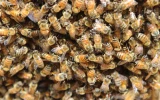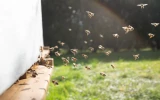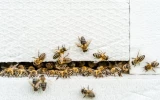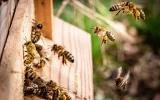The Ultimate Guide To Beekeeping in Hot Weather
Warmer weather can bring unique challenges to both you and your bees. As a beekeeper, it's critical to understand the potential issues that may arise during hot weather and equip yourself with the knowledge and techniques to keep your bees healthy and thriving.
For successful beekeeping in hot weather, monitor your hive for mites and swarms, maintain an optimal colony temperature by providing ventilation in beehives, ensure adequate water is nearby, choose appropriate protective gear for working in the heat, and familiarize yourself with the right strategies to ensure your bees stay productive.
Hot weather can be tough on honey bees, as they need to maintain a specific temperature within their hive for the proper development of their brood and to undertake various activities. As temperatures rise, you'll need to provide your bees with extra support to help them combat these challenges. Let's dive into the details of caring for your bee colony during hot weather.
Summary
- When temperatures soar, ensure your beehive is well-ventilated. Install screened bottom boards and open the hive entrance to create cross-ventilation.
- Make sure the beehives are in a shady spot with good airflow. Provide water sources for the bees.
- Monitor the beehives for signs of stress, and adjust your management accordingly. Be prepared for increased stinging in hotter weather.
- Be mindful of your attire when working with bees in hot weather. Opt for breathable and lightweight protective clothing.
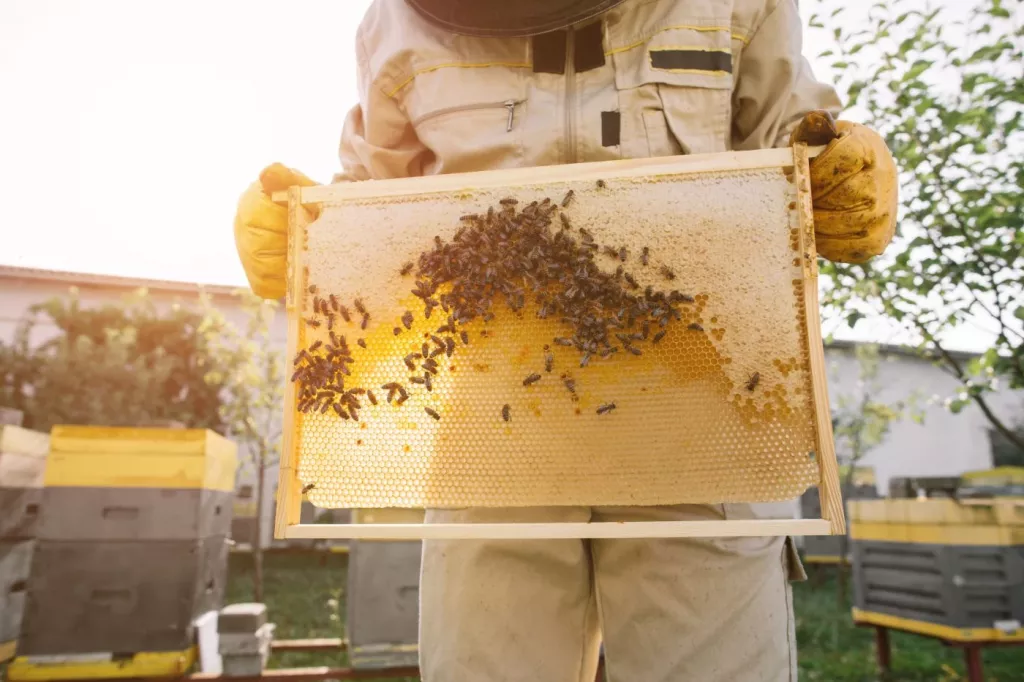
On this page:
In-Depth Guide to Beekeeping in Hot Weather
As you venture into beekeeping in hot weather, it's essential to be proactive in managing the heat and its effects on your hives. By following the guidelines outlined here and adapting to the unique challenges that hot weather presents to beekeeping, you'll be well-prepared to keep your bees healthy and thriving throughout the summer months.
As a beekeeper, it's important to understand the challenges that arise during hot weather conditions. By learning how excessive heat affects bees and addressing water scarcity, you can help your colonies thrive even in the most demanding circumstances.
Excessive heat impact on bees
Extreme heat can have significant effects on your bees' behavior and overall health. When temperatures rise, bees may become less active and forage less, resulting in reduced honey production. High temperatures also increase the risk of heat stress, which can cause your bees to behave erratically and reduce their efficiency in maintaining colony temperature and humidity levels.
Another challenge caused by excessive heat is the need for increased ventilation within the hive. During hot weather, your bees may gather at the entrance or even hang outside the hive to help regulate temperature. Be attentive to these changes and take appropriate action to aid in temperature regulation. We'll look at ventilation in a bit more detail later on.
Water scarcity and bees
Bees require water not only for drinking but also for maintaining the right humidity levels within the hive and cooling it by evaporating water over the brood. Water is essential for the survival and well-being of your bees, especially during hot weather periods.
Unfortunately, the same hot weather that increases your bees' water requirements can also lead to water scarcity. It's your responsibility to ensure that your bees have access to a reliable water source. One option is to provide a shallow tray filled with water and pebbles, which prevents your bees from drowning when they come to drink. Make sure to monitor and replenish the water supply regularly.
By understanding the challenges posed by hot weather and taking appropriate steps to address these concerns, you can help ensure that your bees remain healthy and productive throughout the season.
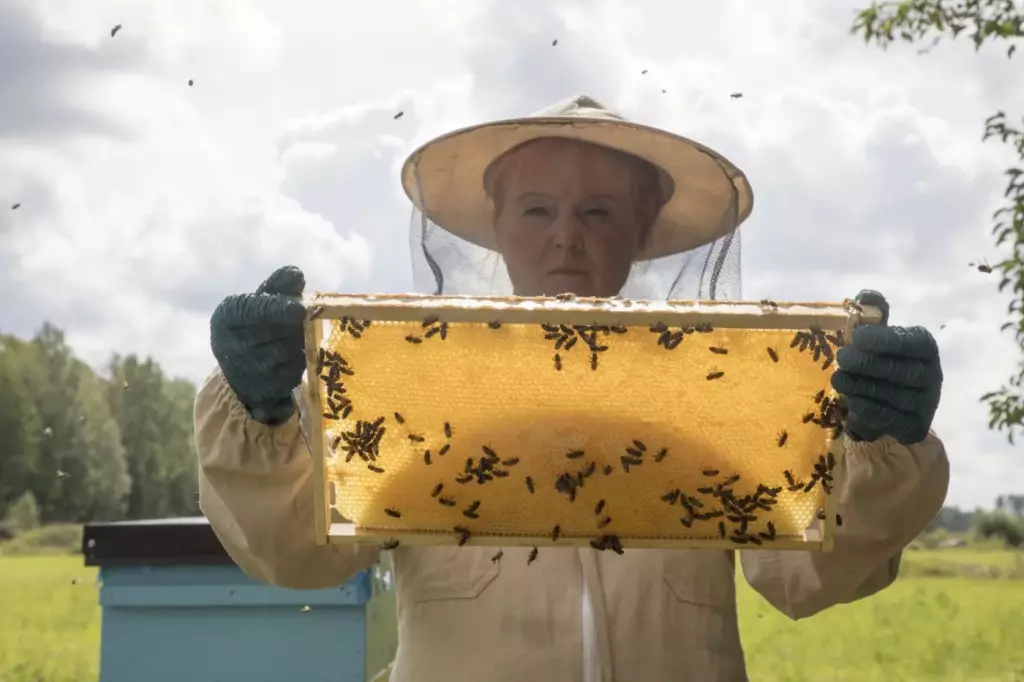
Beehive Location and Setup in Hot Weather
Location selection for beehives
You want to select a spot that receives early morning sun and afternoon shade, providing your bees with optimal working conditions. In addition, look for a location with a windbreak in place to protect your hive from harsh weather conditions and to ensure your bees remain active. Choosing the right location for your beehive is crucial in hot weather.
Proper ventilation of beehives
Ensure the hive design allows for proper air circulation by providing space between the frames and boxes. This helps regulate the hive's temperature, maintain ideal humidity levels, and keep your bees healthy. Good ventilation is crucial for your beehive's success during hot weather.
Some effective methods for increasing ventilation in your hive include:
- Using a screened bottom board, which allows for better air circulation and helps control pests
- Cracking the lid slightly to allow hot air to escape from the top of the hive
- Adding extra ventilation holes in the beehive body, ensuring to cover them with a screen to prevent pests from entering the hive
Shade management of beehives
Aim for a location that receives sunlight in the morning and is shaded in the afternoon, keeping the hive's temperature optimal for your bees. Managing shade is important for beehive placement in hot weather.
If natural shade is unavailable in your desired location, consider constructing a shade structure to protect your beehive from direct sunlight during hot afternoons. Materials such as wooden planks, tarps, or even shade cloth can be used to create a simple yet effective shade structure for your beehive.
Hydration and Water Sources for Your Bees
During hot weather, it is crucial to ensure your bees have access to enough water to maintain their health and hive activity. In this section, we'll cover two sub-topics: providing fresh water, and creating a bee-friendly water source. By following these tips, you'll keep your bees hydrated and happy in the scorching heat.
Providing fresh water to bees
Bees need fresh water to cool their hives, feed their larvae, and dilute their honey. To make sure your bees have access to clean water, follow these steps:
- Place a water source close to your hive, ideally within 10 feet, to reduce foraging energy and time
- Refresh the water daily to prevent stagnation and the growth of algae or bacteria
- Use a shallow container with sloping sides so bees can easily land, drink and take off
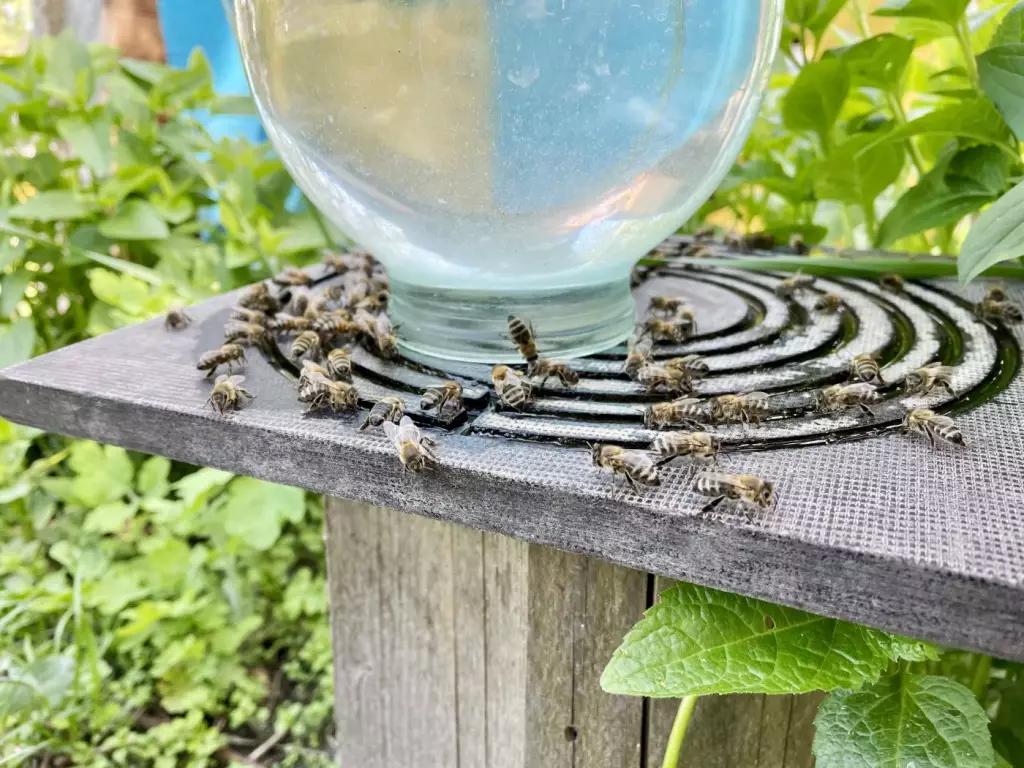
Creating a bee-friendly water source
Aside from providing fresh water, also strive to make the water source as bee-friendly as possible. Here's how:
- Use marbles or pebbles in the container to provide landing spots and prevent drowning, as suggested by Bay Nature
- Consider adding a few drops of essential oils like lemongrass or lavender to attract the bees and encourage them to use your water source
- Ensure that your water source is located in a shaded area to help maintain a cooler temperature
- Monitor the container for signs of any pests or predators, such as ants, wasps, or birds that may bother your bees while they drink
By implementing these practices, you can effectively support your bees' hydration needs during hot weather, allowing them to thrive and continue their important work in your apiary.
Monitoring and Inspecting the Beehive in Hot Weather
High temperatures can cause various issues for your colony, such as overheating, dehydration, and a decrease in productivity. In hot weather, it's especially important for you to closely monitor and inspect your beehive. This section will guide you through daily inspections and the use of thermal imaging tools to ensure the health and safety of your bees during hot weather.
Daily inspections of beehives
During hot weather, perform daily inspections of your beehive. This will help you identify any potential issues and take action before they worsen. When inspecting the hive, pay attention to the following points:
- Check for signs of overheating, such as bees clustering around the entrance or excessive fanning of wings.
- Ensure the water supply is sufficient and easily accessible to the bees.
- Examine the brood pattern and look for any signs of disease or pests.
- Make sure there is enough space within the hive for proper ventilation and expansion.
By performing daily hive inspections and addressing any issues promptly, you can help your bees better cope with the hot weather and maintain a healthy colony.
Thermal imaging tools for beehives
Thermal imaging tools can be valuable assets when monitoring your beehive during hot weather. These devices use infrared technology to detect temperature variations within the hive, allowing you to keep a close eye on the conditions inside without opening it up and disturbing the bees too often.
Some benefits of using thermal imaging tools for hive inspections include:
- Detecting hot spots, which could indicate issues with ventilation, crowding, or disease in your hive.
- Monitoring the overall temperature of the hive to ensure it remains within a healthy range for your bees.
- Identifying areas where additional insulation or shade may be needed to help maintain a comfortable temperature within the hive.
Investing in a thermal imaging tool can be a wise decision for beekeepers in hot climates, as it provides valuable information that can help you maintain a thriving and healthy bee colony.
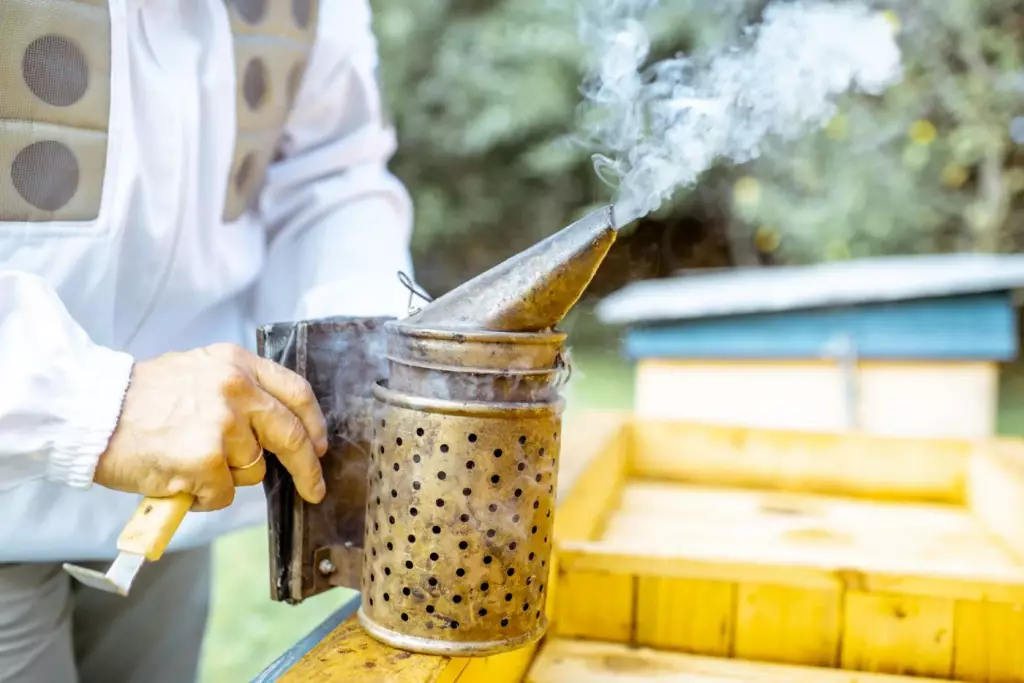
Managing Pests and Diseases that Affect Bees
As a beekeeper, you need to be aware of the various pests and diseases that can affect your honeybees, especially during hot weather. In this section, we will look at preventing pests and controlling diseases, focusing on hot climates.
Preventing pests that threaten bees
Prevention is key when it comes to managing pests in your beekeeping operation. One of the most common pests, the varroa mite, can weaken your bees by feeding on their hemolymph and even spread viruses and diseases.
To prevent pests in your colonies, consider these steps:
- Regular inspections: Keep a close eye on your hives and perform inspections to look for signs of pests or diseases. Early identification can make it significantly easier to address the issue.
- Maintaining hive cleanliness: Clean your hives routinely and ensure proper ventilation to discourage pests from inhabiting your apiary.
- Using mite-resistant stock: When requeening, consider using stock that is known for its resistance to varroa mites.
Disease control in hot weather beekeeping
Diseases can thrive in hot weather, making it particularly important to take preventative measures during these times. Some common honeybee diseases include American foulbrood, European foulbrood, and nosema. Here are a few ways to manage disease outbreaks:
- Integrated Pest Management (IPM) principles: Applying IPM principles such as cultural, mechanical, and chemical control methods can help prevent and control diseases that may affect your honeybees.
- Proper hive management: Ensure proper ventilation in your hives and maintain cleanliness. This can help prevent diseases from taking hold in your colony.
- Feeding supplements: Providing your bees with essential nutrients can help boost their immune systems, making them better equipped to fight off diseases during hot weather.
By following these preventive measures and actively managing your bee colonies during hot weather, you can minimize the risks of pest infestations and disease outbreaks, keeping your bees healthy and productive.
Choosing the Right Bees for Hot Weather
When it comes to beekeeping in hot weather, selecting the right bee species is crucial for the success of your apiary. Bees that are adapted to thrive in warm temperatures will ensure higher productivity and better honey yields.
Africanized bees
You might want to consider Africanized bees, as they are well-suited to hot climates. These bees, often referred to as "killer bees," are a hybrid species created by crossbreeding European honey bees and African bees. While they have a reputation for aggression, Africanized bees have excellent traits for beekeeping in hot weather:
- Resistant to certain pests and diseases
- Efficient workers in hot conditions
- Increased honey production in higher temperatures
It's important to remember that Africanized bees can be more defensive than other bee species. Therefore, extra precautions and experience in beekeeping are essential when working with these bees.
Other adaptive bee species
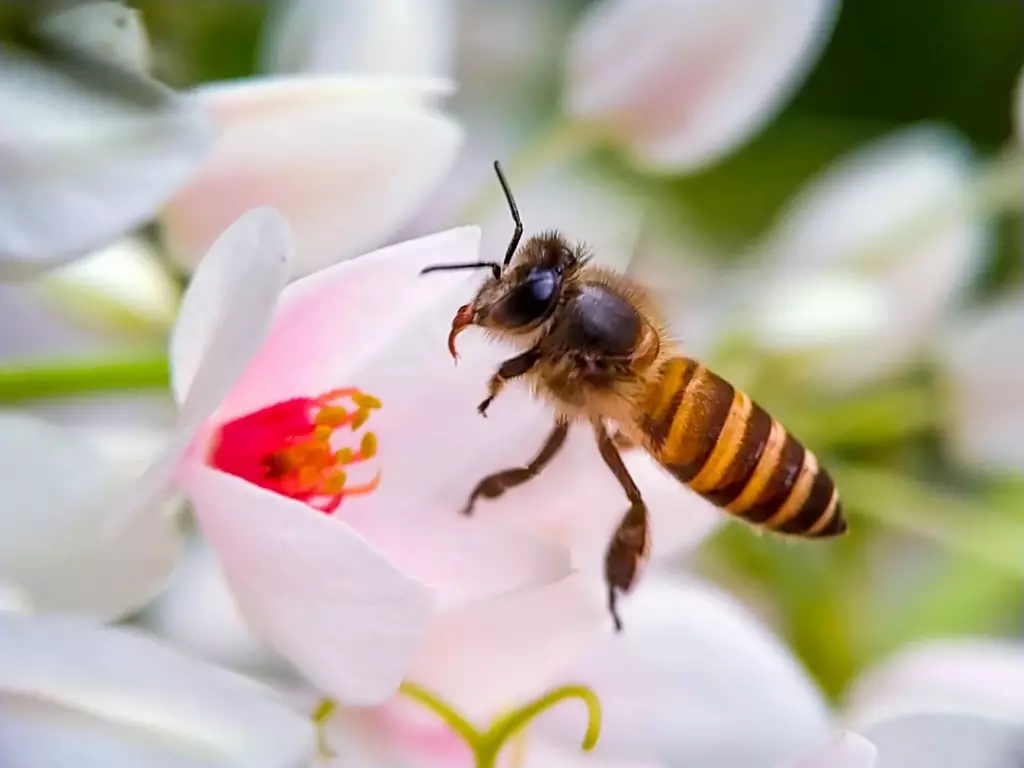
Apart from Africanized bees, there are other bee species that are more adaptive to hot weather conditions. Ensure that the bee species you choose for your apiary is compatible with your location's climate and local flora. Observing wild bees in your area can give you a good indication of which species are naturally thriving in the local ecosystem.
By selecting bee species that are well-adapted to hot temperatures, you'll be better prepared to manage your apiary successfully and maximize honey production in warmer weather conditions. Some of these species include:
- Apis cerana, also known as the Asian honey bee, is adapted to tropical regions and can tolerate heat, humidity, and heavy rainfall.
- Apis dorsata, commonly known as the giant honey bee, is native to South and Southeast Asia and is well-suited for hot and humid climates.
- Apis mellifera scutellata, a subspecies of the European honey bee, is native to Africa and has well-adapted genetics for beekeeping in hot climates.
